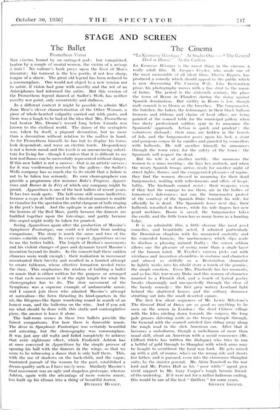The Ballet STAGE AND SCREEN
Prometheus Victus
NoT rinctus, bound by an outraged god ; but vanquished, beaten by a couple of mortal women, the victim of a menage a trois! No vulture's beak preys upon the liver of Man's liberator ; his torment is the less poetic, if not less sharp, tongue of a shrew. The great old legend has been reduced to a commonplace. One would not object to a new version nor to satire, if vision had gone with novelty and the wit of an AristOphanes had informed the satire. But this version of the Prometheus legend danced at Sadler's Wells 'has neither novelty nor point, only eccentricity and dullness.
In a different context it might be possible to admire Miss June Brac's clever characterisation of the Other Woman, a piece of whole-hearted vulgarity carried out with gusto, and there was a laugh to be had at the idea that Mrs. Prometheus had beaten Mrs. Dionne's record long before Canada was known to the civilised world. The dance of the sextuplets was, taken by itself, a piquant decoration, but no more than a decoration without relation to the natter in hand. As for Prometheus himself, he has but to display his torso, look despondent, and wave an electric torch. Despondency is not a heroic mood and the torch is an unconvincing substi- tute for living fire—though I confess that it is difficult to see how real flames can be successfully represented without danger. If this new ballet is not a success—that is an artistic success ;
for it was vociferously received by the gallery—the Sadler's Wells company has so much else to its credit that a failure is not to be taken too seriously. Its own choreographers can provide a programme (for instance Rake's Progress, Appari- tions and Baiser de la Fee) of which any company might be proud. Apparitions is one of the best ballets of recent years. It has two weak spots. The bell-scene still seems ineffective, because a corps de ballet used in the classical manner is unable to visualise for the spectator the awful clangour of bells ringing in the poet's head. And the epilogue is an anti-climax after the horrors of the Red Mass, partly because the dancers arc huddled. together upon the fore-stage, and partly because this sequel might really be taken for granted.
Seeing Apparitions again after the production of Massine's Symphonic Fantastique, one could not refrain from making comparisons. The story is much the same and two of the scenes coincide exactly. In every respect Apparitions seems to me the better ballet. The length of Berlioz's movements and his violent changes of pace and dynamic taxed Massinc's invention beyond its limits. In the concert-hall these sudden climaxes seem weak enough ; their realisation in movement accentuated their brevity and resulted in a hurried attempt to create tableaux, whose effective formation needed twice the time. This emphasises the wisdom of building a ballet on music that is either written for the purpose or arranged so that each movement is of the right length for what the choreographer has to do. The slow movement of the Symphony was a supreme example of undanceable music, and I cannot join those who admired Massine's attempt at surrealism—the fawn thrusting its hind-quarters in the air, the Diogenes-like figure wandering round in search of an honest man, and the ballerina on the wire. And if you ask me what should be done with this static and contemplative piece, the answer is leave it alone.
The ball-room scenes in these two ballets provide the
fairest comparisons. For here there is danceable music. The decor in Symphonic Fantastique was certainly beautiful and arresting, but the choreography was commonplace. It ,was just any old waltz and failed completely to achieve that eerie nightmare effect, which Frederick Ashton has at once conveyed in Apparitions by the simple process of opening his ball with the dancers in the wings, so that we seem to be witnessing a dance that is only half there. This, with the use of shadows on the back-cloth, and the vague, frustrated pursuit of the woman by the poet, established a dream-quality such as I have rarely seen. Similarly Massinc's final movement was an ugly and shapeless grotesque, whereas Ashton, again with the advantage of more concise music, has built up his climax into a thing of beautiful horror.
DYNELEY HUSSEY.




















































 Previous page
Previous page